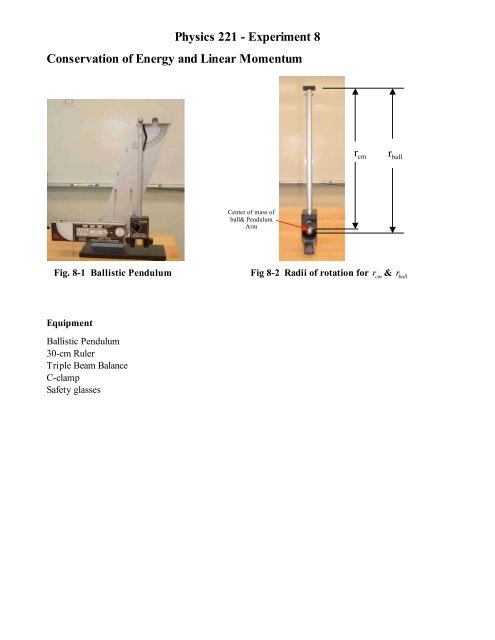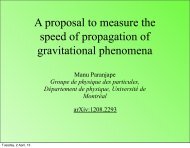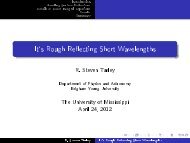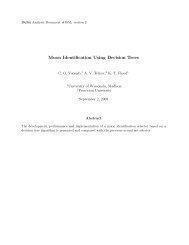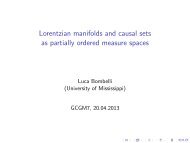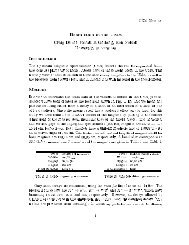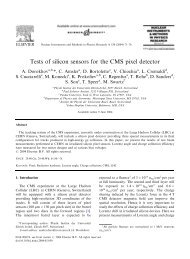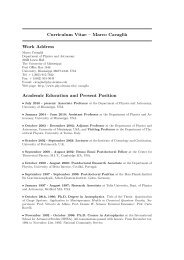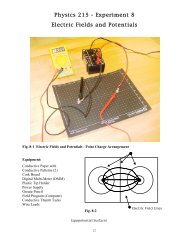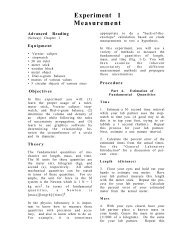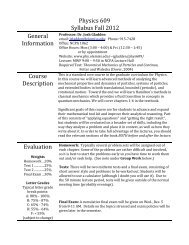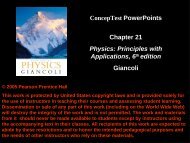8. Conservation of Energy & Momentum
8. Conservation of Energy & Momentum
8. Conservation of Energy & Momentum
You also want an ePaper? Increase the reach of your titles
YUMPU automatically turns print PDFs into web optimized ePapers that Google loves.
Physics 221 - Experiment 8<br />
<strong>Conservation</strong> <strong>of</strong> <strong>Energy</strong> and Linear <strong>Momentum</strong><br />
r cm<br />
r ball<br />
Center <strong>of</strong> mass <strong>of</strong><br />
ball& Pendulum<br />
Arm<br />
Fig. 8-1 Ballistic Pendulum<br />
Fig 8-2 Radii <strong>of</strong> rotation for r cm<br />
& r ball<br />
Equipment<br />
Ballistic Pendulum<br />
30-cm Ruler<br />
Triple Beam Balance<br />
C-clamp<br />
Safety glasses
Physics 221 - Experiment 8<br />
<strong>Conservation</strong> <strong>of</strong> <strong>Energy</strong> and <strong>Momentum</strong><br />
Advance Reading<br />
Serway & Jewitt, Chapter, 8 Section 8-2.<br />
Chapter 9, Sections 9-1, 9-2 & 9-4. Note the<br />
difference between elastic and inelastic<br />
collisions.<br />
Objective<br />
To determine the speed <strong>of</strong> the ball as it leaves<br />
the ballistic pendulum using conservation <strong>of</strong><br />
linear momentum and conservation <strong>of</strong> energy<br />
considerations.<br />
Theory<br />
In this experiment an inelastic collision will<br />
occur between the ball and the ballistic<br />
pendulum arm. The momentum <strong>of</strong> the system<br />
before and after the collision must be the same<br />
(i.e., as always, momentum [both linear and<br />
angular] is conserved). The pendulum arm and<br />
ball are assumed to be point masses. We can<br />
then write<br />
m b<br />
v b<br />
+ M pa<br />
v pa<br />
= m b<br />
v b<br />
'<br />
'<br />
+ M pa<br />
v pa<br />
(Eq. 8-1)<br />
In this case, m b<br />
is the mass <strong>of</strong> the ball and M pa<br />
is the mass <strong>of</strong> the pendulum arm. Before the<br />
collision, the ball has a velocity <strong>of</strong> v b<br />
and the<br />
pendulum arm has a velocity <strong>of</strong> v pa<br />
.<br />
The collision is perfectly inelastic, with the ball<br />
being caught by the pendulum arm, so that the<br />
velocities on the right-hand side <strong>of</strong> Eq. 8-1 are<br />
equal. Label this velocity V pab<br />
. The mass <strong>of</strong><br />
the pendulum-ball system is m b<br />
+ M pa<br />
. The<br />
result <strong>of</strong> this is:<br />
m b<br />
v b<br />
= (m b<br />
+ M pa<br />
)V pab<br />
(Eq. 8-2)<br />
Mechanical energy is not conserved during<br />
an inelastic collision, but just after the<br />
collision (again the pendulum arm and ball are<br />
assumed to be point masses) the pendulum-ball<br />
system has kinetic energy (KE = 1/2mv 2 ).<br />
We assume this kinetic energy is conserved and<br />
transformed into gravitational potential energy<br />
(PE = mgh) as the pendulum arm swings up. In<br />
mathematical form KE i = PE f , or:<br />
1<br />
(m + M )V 2<br />
2 b pa pab<br />
= (m b<br />
+ M pa<br />
)g!h (Eq. 8-3)<br />
By measuring the rise <strong>of</strong> the center <strong>of</strong> mass <strong>of</strong><br />
the system, ∆h, the initial velocity <strong>of</strong> the ball<br />
can be determined. The center <strong>of</strong> mass <strong>of</strong> the<br />
pendulum arm is indicated on fig. 8-2. This is<br />
the reference point for initial and final height.<br />
When the ball is fired, it causes the arm to rise<br />
and the angle is indicated. Use this angle and the<br />
radius <strong>of</strong> the center <strong>of</strong> mass, r cm<br />
, to calculate<br />
!h.<br />
PROCEDURE<br />
1. Measure and record the mass <strong>of</strong> the ball,<br />
m b<br />
. Carefully remove the arm from the<br />
ballistic pendulum. Measure and record the<br />
mass <strong>of</strong> the pendulum arm, M pa<br />
2. Measure the distance from the axis <strong>of</strong><br />
rotation to the center <strong>of</strong> mass <strong>of</strong> pendulum<br />
and ball, r cm<br />
. See Fig. 8-2. Next, measure the<br />
distance from the axis <strong>of</strong> rotation to the<br />
center <strong>of</strong> mass <strong>of</strong> the ball, r ball<br />
. See Fig. 8-2.<br />
3. Reattach the arm on the ballistic pendulum.<br />
Before firing:<br />
Do not aim at people or computers!<br />
2
Physics 221 - Experiment 8<br />
<strong>Conservation</strong> <strong>of</strong> <strong>Energy</strong> and <strong>Momentum</strong><br />
4. Place the ball on the firing mechanism.<br />
Cock the firing mechanism to the 3rd detent<br />
position. Fire the ball into the pendulum<br />
arm catcher.<br />
5. Measure and record the new angle;<br />
calculate Δh.<br />
6. Calculate the velocity <strong>of</strong> the ball,v b<br />
using<br />
Eq. 5-2 and Eq. 5-3.<br />
7. Repeat Steps 4-6 twice. Average the v b<br />
for<br />
the three trials.<br />
<strong>8.</strong> Repeat (3 trials) for the 1st detent.<br />
from the center <strong>of</strong> mass <strong>of</strong> the ball to the<br />
axis <strong>of</strong> rotation. See step 2.<br />
Since ! pab<br />
= V pab<br />
, the equation above can<br />
be written as<br />
r cm<br />
m b<br />
v b<br />
r ball<br />
= I pab<br />
V pab<br />
r cm<br />
. Eq-5-4<br />
Equation 8-3 now becomes<br />
1<br />
(I 2<br />
2 pab<br />
)! pab<br />
= (m b<br />
+ M pa<br />
)g"h .<br />
Questions<br />
1. For each position (1st & 3rd detent):<br />
• Calculate the mechanical energy <strong>of</strong> the<br />
system just before the collision.<br />
• Calculate the mechanical energy <strong>of</strong> the<br />
system just after the collision.<br />
• What percent <strong>of</strong> the initial mechanical<br />
energy remains after the collision? What<br />
happened to the “lost” mechanical energy?<br />
2. Assume that the ballistic pendulum was not<br />
held firmly to the table when it was fired.<br />
What effect would this have on the velocity<br />
<strong>of</strong> the ball? Explain.<br />
3. It was assumed that the pendulum arm<br />
system was a point mass. This is not true.<br />
Rather than conservation <strong>of</strong> linear<br />
momentum, conservation <strong>of</strong> angular<br />
momentum should be used, and equation 8-<br />
2 can be written as<br />
Again, since ! pab<br />
= V pab<br />
, the equation<br />
r cm<br />
above can be written as<br />
1<br />
(I 2 pab) V 2<br />
pab<br />
= (m<br />
2 b<br />
+ M PA<br />
)g!h Eq-5-5<br />
r cm<br />
Using I pab<br />
=0.025 kg-m 2 , your measured<br />
values for masses, r ball<br />
, r cm<br />
and Eqs- 8-4 &<br />
8-5 above, calculate the velocity <strong>of</strong> the<br />
ball, v b<br />
for the 1 st and 3 rd detent.<br />
Was the assumption <strong>of</strong> the system being<br />
point masses a reasonable assumption.<br />
Show all work.<br />
L initial<br />
= L final<br />
= m b<br />
v b<br />
r ball<br />
= I pab<br />
! pab<br />
where I pab<br />
is the moment <strong>of</strong> inertia <strong>of</strong><br />
pendulum arm and ball system, v b<br />
is the<br />
velocity <strong>of</strong> the ball and r ball<br />
is the distance<br />
3


